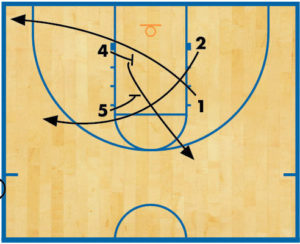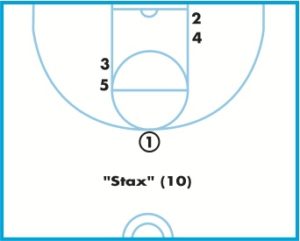4-1 zone defense bewilders opponents
Prior to accepting a position as a junior varsity coach at a larger, public high school a few years ago, I worked as the varsity head coach at a tiny private school (Northeast Christian Academy in Kingwood, Texas). The enrollment was approximately 100 students, yet we found a way to build the program into a state-championship contender that also was capable of competing with and beating some of the largest public schools in the state.
 To do this we employed a solid defensive system that revolved around changing defenses. A multitude of defenses keeps the offense out of its comfort zone. Throw in some presses and you always are one step ahead of your opponents at all times.
To do this we employed a solid defensive system that revolved around changing defenses. A multitude of defenses keeps the offense out of its comfort zone. Throw in some presses and you always are one step ahead of your opponents at all times.
Of all the defenses we ran, one that worked exceptionally well was the 4-1 zone, which is a defensive set that all coaches should consider using.
Philosophy behind the 4-1 zone
The 4-1 developed from wanting to put together a defense no one had seen in the past. If offenses haven’t seen it, how could they beat it?
Originally, the intentions behind the 4-1 was to make it a junk defense only for use for a few possessions at a time. After tinkering with rotations and experimenting with traps, however, it now is one of my teams’ most-effective defensive schemes.
Before jumping into the diagrams and how to coordinate this defense, it’s important to know a couple of the major principles behind it — rebounding and post defense.
Rotations in the 4-1 zone defense almost always ensures that there are three players in the lane at all times. This especially is true if the ball is kept out of “The Funnel, which is a term used to describe the middle one-third of the floor.
You always should rebound well out of this zone because of the coverage you have on both the strong and weak sides. And, there is a player in the middle of the lane at all times. When combining this post coverage with constant ball pressure, you are in a favorable defensive-rebounding position at all times.
The 4-1 also leads to superior post defense as it is effective in limiting a strong post player and negating a weak one.
The first line of defense against any type of strong post presence is solid ball pressure. A soft trap hopefully makes any entry pass from the wing to the block difficult. Any attempt to enter the ball to the post from the baseline corner is almost impossible due to the number of strong-side defenders.
We have experimented with post-to-post trapping in the 4-1 but have found that a three-quarter front is the best way to defend players in this scheme. Have your players play the post on the high side when the ball is above the foul-line extended. Rotate to a three-quarter front from the baseline side when the ball moves below the foul-line extended.
In the event that an entry pass is made, the post defender rotates and plays behind while the ball is in the air to the post. On the pass, our defense “chokes the post” with help coming from the strong-side wing.
With these philosophies in mind, check out the specifics of the 4-1 defense in the following diagrams.
Base & defending the funnel
The base defense obviously looks like a 4-1 set. However, this is the only time the zone actually looks like a 4-1, which keeps the defense guessing. Divide the court into thirds and always keep the ball out of the “funnel” as show in Diagrams 2 and 3. Doing so allows your players to rotate in such a way that they are capable of providing help for the on-ball defenders.
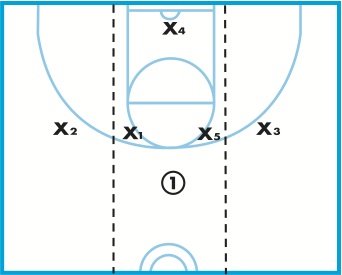
DIAGRAM 1: Base formation. Pictured is the base formation with lines indicating how the court is divided into thirds. Ideally, X4 is your best post defender and best rebounder. X4 also is the quarterback of the defense. X4 is asked to communicate with the other defenders as to the whereabouts of the opposition’s players (like calling out cutters, posts, high post, baseline, corner, etc.).
X2 and X3 are your best defenders and best athletes. They also need to be good rebounders because they have many backside rebounding opportunities in the 4-1. And, they are responsible for covering the most ground.
X1 and X5 need to be solid help defenders and they share the responsibility for covering the high post in almost every situation.
The keys to making this defense work are communication, having players understanding and fulfilling their responsibilities and having five players rotate as one.
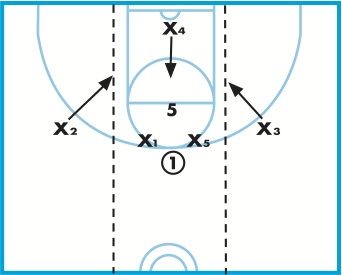
DIAGRAM 2: Defending the funnel (A). As the point guard brings the ball into the front court, the four players in the front of the zone bounce and fan.
This means they resemble a jumping jack (jumping with arms extended to the side) and while unorthodox, this technique serves a purpose within the flow of the defense.
When 1 approaches the three-point line, X1 and X5 both defend that player. X1 and X5 continue to bounce and fan and form a soft trap. Their goal is to contain 1 or to get 1 to pass the ball. Neither player needs to extend very far beyond the three-point line to accomplish either of these goals. The purpose of the bounce-and-fan in a soft-trap situation is to force any pass to be a lob pass, thus providing the defenders more of a chance to make an effective defensive rotation. It also discourages shot attempts.
As X1 and X5 are containing 1, X4 rotates up the lane to defend the high-post area. X2 and X3 rotate from the wing to the edge of the funnel at an angle that takes them directly to the block on their respective sides of the floor.
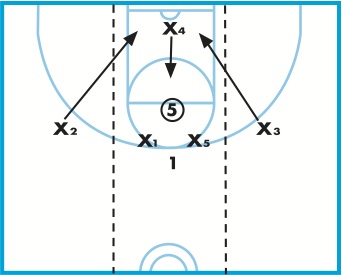
DIAGRAM 3: Defending the funnel (B). If 1 is able to enter the ball to 5, X4 covers 5. X2 and X3 rotate to the block on their side of the court with the purpose of denying any interior passes and providing help to X4.
In this situation, the zone ends up looking like a 2-1-2.

